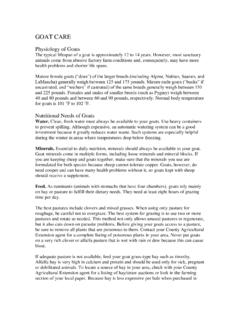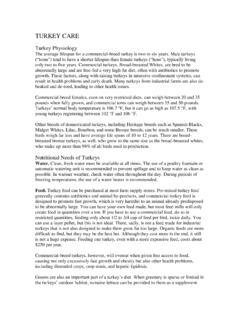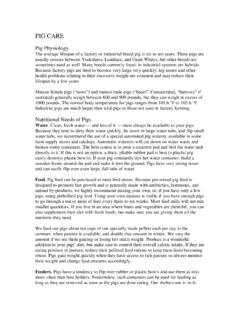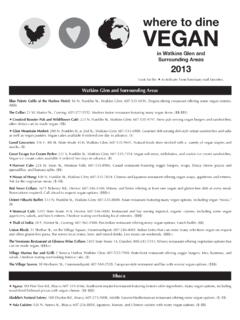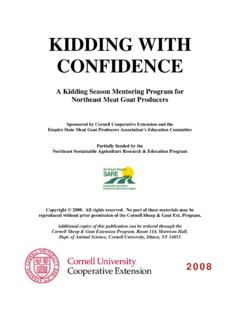Transcription of GOAT CARE - Farm Sanctuary
1 goat care . Physiology of Goats The typical lifespan of a goat is approximately 12 to 14 years. However, most Sanctuary animals come from abusive factory farm conditions and, consequently, may have more health problems and shorter life spans. Mature female goats ( does ) of the larger breeds (including Alpine, Nubian, Saanen, and LaMancha) generally weigh between 125 and 175 pounds. Mature male goats ( bucks if uncastrated, and wethers if castrated) of the same breeds generally weigh between 150. and 225 pounds. Females and males of smaller breeds (such as Pygmy) weigh between 40 and 80 pounds and between 60 and 90 pounds, respectively.
2 Normal body temperature for goats is 101 F to 102 F. Nutritional Needs of Goats Water. Clean, fresh water must always be available to your goats. Use heavy containers to prevent spilling. Although expensive, an automatic watering system can be a good investment because it greatly reduces water waste. Such systems are especially helpful during the winter in areas where temperatures drop below freezing. Minerals. Essential to daily nutrition, minerals should always be available to your goat . goat minerals come in multiple forms, including loose minerals and mineral blocks.
3 If you are keeping sheep and goats together, make sure that the minerals you use are formulated for both species because sheep cannot tolerate copper. Goats, however, do need cooper and can have many health problems without it, so goats kept with sheep should receive a supplement. Feed. As ruminants (animals with stomachs that have four chambers), goats rely mainly on hay or pasture to fulfill their dietary needs. They need at least eight hours of grazing time per day. The best pastures include clovers and mixed grasses. When using only pasture for roughage, be careful not to overgraze.
4 The best system for grazing is to use two or more pastures and rotate as needed. This method not only allows unused pastures to regenerate, but it also cuts down on parasite problems. Before giving your goats access to a pasture, be sure to remove all plants that are poisonous to them. Contact your County Agricultural Extension agent for a complete listing of poisonous plants in your area. Never put goats on a very rich clover or alfalfa pasture that is wet with rain or dew because this can cause bloat. If adequate pasture is not available, feed your goat grass-type hay such as timothy.
5 Alfalfa hay is very high in calcium and protein and should be used only for sick, pregnant or debilitated animals. To locate a source of hay in your area, check with your County Agricultural Extension agent for a listing of hay/straw auctions or look in the farming section of your local paper. Because hay is less expensive per bale when purchased in large quantities, building some type of hay storage structure or loft can be well worth the investment if you have more than a few goats. Goats are born browsers and actually seem to prefer eating leaves, weeds, briars, and other plants to grazing only on grasses.
6 Make sure you have a full list of plants that are toxic to goats because they are numerous. Many ornamental plants, such as rhododendron, can be fatal to goats. Because grain is very high in fat and causes kidney and bladder stones in goats, especially wethers, we discourage feeding it regularly to healthy goats. It may, however, be used to supplement hay or pasture for goats with dental issues or other ailments that cause unhealthy weight loss. When feeding grain to wethers, use a grain that contains ammonium chloride to help prevent stones from forming.
7 Monitor all goats for obesity, which is very unhealthy for them. Older goats can easily gain too much weight on even small amounts of feed or hay. Handling Goats When working with goats, be very calm and gentle in your approach. Goats are nervous by nature and will spook easily if you yell or handle them roughly. When handling your goats, use a rope halter (available at farm supply stores or through catalogs). If your goats have horns, these can also be held to control them, although some goats do not like this. It is best to have a second person to assist you.
8 Handling your goat too roughly will cause him to struggle more, so the best amount of restraint is just enough to keep him still. Shelter Requirements for Goats Building. For goat housing, we recommend the use of a pole barn, not a shed. We also recommend dirt floors over wood ones, which can be slippery and therefore put goats at risk of torn ligaments and joint damage. Allow at least 25 square feet per goat , and be sure the shelter has good ventilation and no direct drafts. Always provide your goats with plenty of clean, dry straw for bedding.
9 Remove damp and soiled straw daily, replacing it with fresh straw. Lightly spreading hydrated lime on any wet areas will help control moisture and prevent the spread of bacteria. Fencing. In addition to adequate shelter, goats need a fenced-in outdoor area. The ideal fencing to use for goats is 4-foot-high, woven wire, no climb horse fencing, available at farm supply stores. High tensile electric fencing can also be used, especially if you are housing cattle and goats together. Field fencing, which has large, square openings, puts goats, especially those with horns, at risk of getting their heads caught.
10 Regularly walk along your fence line to check for holes dug under the fencing by predators. Tethering. Tethering your goats (putting them on a long leash) is not recommended as it can be stressful for them. Tethering is also very dangerous because a goat can accidentally hang himself on a tether. Pasture. We recommend one acre of land for every two goats, although the amount of pasture necessary varies according to the quantity of hay the goats are fed. For warm weather, the fenced area must have plenty of shade. Erect fences around any shade trees you want to keep because goats are great landscapers and will destroy unprotected trees.
